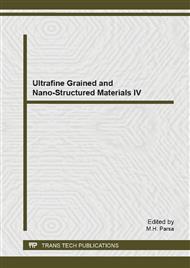[1]
Y. Estrin, A. Vinogradov, Extreme grain refinement by severe plastic deformation: A wealth of challenging science, Acta Mater. 61 (2013) 782-817.
DOI: 10.1016/j.actamat.2012.10.038
Google Scholar
[2]
I. Sabirov, M.Y. Murashkin, R. Z. Valiev, Nanostructured aluminium alloys produced by severe plastic deformation: New horizons in development, Mater. Sci. Eng. A 560 (2013) 1-24.
DOI: 10.1016/j.msea.2012.09.020
Google Scholar
[3]
R.Z. Valiev, T.G. Langdon, Principles of equal-channel angular pressing as a processing tool for grain refinement, Prog. Mater. Sci. 51 (2006) 881–981.
DOI: 10.1016/j.pmatsci.2006.02.003
Google Scholar
[4]
A.P. Zhilyaev, T.G. Langdon, Using high-pressure torsion for metal processing: Fundamentals and applications, Prog. Mater. Sci. 53 (2008) 893–979.
DOI: 10.1016/j.pmatsci.2008.03.002
Google Scholar
[5]
Y. Beygelzimer, V. Varyukhin, S. Synkov, D. Orlov, Useful properties of twist extrusion, Mater. Sci. Eng. A 503 (2009) 14–17.
DOI: 10.1016/j.msea.2007.12.055
Google Scholar
[6]
Y. Saito, H. Utsunomiya, N. Tsuji, T. Sakai, Novel ultra-high straining process for bulk materials-development of the accumulative roll-bonding (ARB) process, Acta mater. 47 (1999) 579-583.
DOI: 10.1016/s1359-6454(98)00365-6
Google Scholar
[7]
D. H. Shin, J. -J. Park, Y. -S. Kim, K. -T. Park, Constrained groove pressing and its application to grain refinement of aluminum, Mater. Sci. Eng. A 328 (2002) 98–103.
DOI: 10.1016/s0921-5093(01)01665-3
Google Scholar
[8]
R.Z. Valiev, Y. Estrin, Z. Horita, T.G. Langdon, M. J. Zehetbauer, Y.T. Zhu, Producing bulk ultrafine-grained materials by severe plastic deformation, JOM 58 (2006) 33-39.
DOI: 10.1007/s11837-006-0213-7
Google Scholar
[9]
R.Z. Valiev, R.K. Islamgaliev, I.V. Alexandrov, Bulk nanostructured materials from severe plastic deformation, Prog. Mater. Sci. 45 (2000) 103-189.
DOI: 10.1016/s0079-6425(99)00007-9
Google Scholar
[10]
M.H. Parsa, M. Naderi, M. Nili-Ahmadabadi, H. Asadpour, The evolution of strain during equal channel angular pressing, Int. J. Mater. Form. 1 (2008) 93–96.
DOI: 10.1007/s12289-008-0036-x
Google Scholar
[11]
Y. Iwahashi, J. Wang, Z. Horita, M. Nemoto, T.G. Langdon, Principle of equal-channel angular pressing for the processing of ultra-fine grained materials, Scr. Mater. 35 (1996) 143-146.
DOI: 10.1016/1359-6462(96)00107-8
Google Scholar
[12]
S. Li, M.A.M. Bourke, I.J. Beyerlein, D.J. Alexander, B. Clausen, Finite element analysis of the plastic deformation zone and working load in equal channel angular extrusion, Mater. Sci. Eng. A 382 (2004) 217–236.
DOI: 10.1016/j.msea.2004.04.067
Google Scholar
[13]
G.J. Raaba, R.Z. Valiev, T.C. Lowe, Y.T. Zhu, Continuous processing of ultrafine grained Al by ECAP–Conform, Mater. Sci. Eng. A 382 (2004) 30–34.
DOI: 10.1016/j.msea.2004.04.021
Google Scholar
[14]
M. Furukawa, Y. Iwahashi, Z. Horita, M. Nemoto, T.G. Langdon, The shearing characteristics associated with equal-channel angular pressing, Mater. Sci. Eng. A 257 (1998) 328–332.
DOI: 10.1016/s0921-5093(98)00750-3
Google Scholar
[15]
R. Mahmudi, R. Alizadeh, A.R. Geranmayeh, Enhanced superplasticity in equal-channel angularly pressed Sn–5Sb alloy, Scr. Mater. 64 (2011) 521-524.
DOI: 10.1016/j.scriptamat.2010.11.030
Google Scholar


